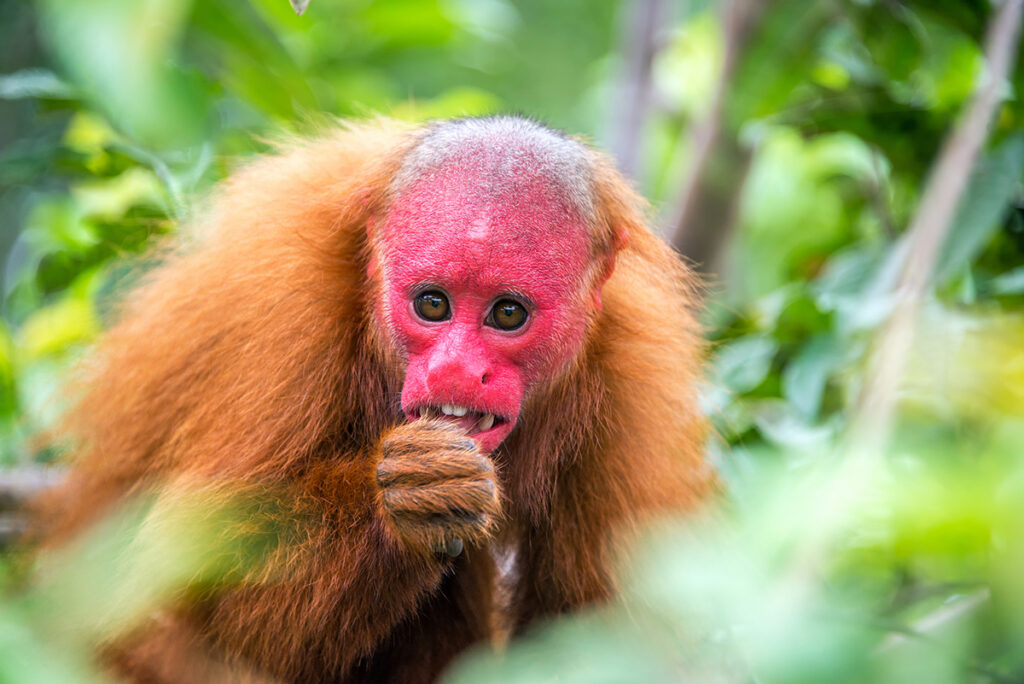Do you want to learn fascinating facts about the bald uakari?
This unique primate, known for its bright red face and lack of hair, has many interesting characteristics.
From its physical appearance to its natural habitat, diet, and social structure, the bald uakari is a captivating creature.
Discover its unique adaptations, communication methods, and the threats it faces in the wild.
The Physical Appearance of Uakaris
You will frequently see bald uakaris with a distinct physical appearance. These unique primates are easily recognizable by their bright red faces. The intensity of the redness can vary among individuals, but it’s always a striking feature. Their faces lack any fur, giving them a bald appearance.
In addition to their red faces, uakaris have a short, stocky body with a long, bushy tail. Their limbs are well-developed, allowing them to move easily through the trees. Uakaris also have a short, wide nose and large, forward-facing eyes, which give them excellent vision. Their teeth are strong and adapted for their omnivorous diet.
The physical appearance of bald uakaris is truly unique and fascinating to observe.
Facts About Their Natural Habitat
Moving on to the next topic, let’s explore some interesting facts about the natural habitat of bald uakaris.
These unique primates are found in the rainforests of South America, specifically in Brazil, Colombia, and Peru. They prefer to live in flooded forests and swampy areas, where they can easily access their primary sources of food – ripe fruits.
Bald uakaris are well adapted to their environment, with their bright red faces serving as a form of communication within their social groups. These forests provide the uakaris with plenty of trees and vegetation for shelter and protection. The dense canopy overhead protects them from predators and provides a safe environment for them to move and forage for food.
The natural habitat of bald uakaris is crucial for their survival and it’s important to protect these fragile ecosystems to ensure the continued existence of these fascinating primates.
Social Structure
Now let’s delve into the social structure of bald uakaris, examining how they interact with each other in their unique rainforest habitat.
Bald uakaris live in large groups known as troops, which can consist of up to a hundred individuals. Within these troops, there’s a clear hierarchy, with dominant males at the top. These dominant males have the privilege of mating with multiple females, ensuring the survival of their genes.
However, the social dynamics within the group aren’t solely determined by dominance. Cooperation and social bonds play a crucial role as well. Bald uakaris engage in grooming behaviors, which help to strengthen social connections and alleviate tension. They also engage in vocalizations, such as sharp barks, to communicate with each other and maintain group cohesion.
Facts About Diet and Feeding Habits
Continuing from the previous subtopic on social structure, bald uakaris have unique dietary preferences and feeding habits.
As a bald uakari, you primarily feed on fruits, making you a frugivore. Your diet consists of a variety of fruits, including figs, palm nuts, and unripe fruits. However, you also consume leaves, flowers, and seeds, especially during the dry season when fruits are scarce.
To extract the seeds from fruits, you use your strong jaws and sharp teeth. Interestingly, you have an enlarged liver and a specialized digestive system that allows you to efficiently process toxins found in certain fruits.
Additionally, as a social primate, you engage in group foraging, where you communicate with your fellow uakaris to locate food sources and share information about feeding opportunities.
Unique Adaptations
As a bald uakari, your unique adaptations play a crucial role in your survival and success in the wild.
One of your most distinctive features is your bright red face, which is caused by the lack of fur and increased blood flow to the skin. This adaptation helps you regulate your body temperature in the hot and humid Amazon rainforest.
Additionally, your short, strong limbs and prehensile tail enable you to move swiftly through the trees and maintain balance while foraging for food.
Your specialized teeth, with large canines and molars, allow you to efficiently chew tough and fibrous fruits, which make up the majority of your diet.
These adaptations have evolved over time to help you thrive in your unique habitat and ensure your continued survival as a bald uakari.
Reproduction and Life Cycle of Uakaris
The Reproduction and Life Cycle of Uakaris involves intricate processes that ensure the continuation of the species. Uakaris, like many primates, have a reproductive system that’s well-adapted for successful reproduction.
Females reach sexual maturity at around four to five years old, while males reach maturity slightly later at around six years old.
During the mating season, males compete for the attention of females by displaying their bright red faces and emitting loud vocalizations. Once a male successfully mates with a female, the gestation period lasts for approximately five to six months.
Uakaris typically give birth to a single offspring, which they care for and nurse until it becomes independent at around one year old.
The life expectancy of a uakari in the wild is estimated to be around 20 years, highlighting the importance of successful reproduction for the survival of this species.
Communication and Vocalizations
To understand the communication and vocalizations of the bald uakari, you must delve into the intricate ways in which these primates express themselves.
The bald uakari uses a combination of vocalizations, facial expressions, and body postures to communicate with its group members. They emit a wide range of vocalizations, including barks, screams, and grunts, each serving a specific purpose.
Barks are used to alert other group members of potential danger, while screams are a form of alarm call. Grunts are used during social interactions to establish dominance or submission.
In addition to vocalizations, the bald uakari also relies on facial expressions, such as raised eyebrows or bared teeth, to convey different messages. Body postures, such as an upright stance or a hunched posture, also play a crucial role in their communication.
Through these various means, the bald uakari is able to effectively communicate within its social group.
Predators and Threats
Watch out for predators and threats that pose a danger to the bald uakari. These unique primates face various challenges in their natural habitat. One of their primary predators is the jaguar, a stealthy and powerful big cat that preys on the uakari’s small size and vulnerability.
In addition to jaguars, other threats include large birds of prey like harpy eagles and anacondas, which can easily overpower them.
Human activities also pose a significant risk to the bald uakari population. Deforestation, habitat loss, and illegal hunting for their meat and fur all contribute to their declining numbers.
Conservation efforts are vital to protect these fascinating creatures from further harm and ensure their survival in the wild.
Conservation Status
While the bald uakari faces numerous threats, it’s important to consider its conservation status.
Currently, the bald uakari is listed as ‘Vulnerable’ on the IUCN Red List of Threatened Species. This means that the species is at a high risk of extinction in the wild.
The main factors contributing to its vulnerable status are habitat loss and fragmentation caused by deforestation, as well as hunting for its meat and fur. The Amazon rainforest, which is the bald uakari’s primary habitat, is being rapidly destroyed, resulting in a decline in their population.
Conservation efforts are crucial to protect and preserve the bald uakari. These include establishing protected areas, promoting sustainable forestry practices, and raising awareness about the importance of conserving this unique primate species.
Other Interesting Facts
Did you know that the bald uakari is known for its distinctive bright red face? This unique primate species, found in the Amazon rainforest, has a face that stands out among other primates. The vibrant red color of its face is caused by blood vessels close to the skin’s surface. Scientists believe that this redness may be an indication of good health and play a role in attracting mates within the uakari community.
Another interesting fact about the bald uakari is its diet. It mainly feeds on fruits, but also consumes leaves, flowers, and seeds. This diverse diet helps to ensure its survival in the challenging rainforest environment.
With its striking appearance and adaptable diet, the bald uakari is a fascinating and important species in the Amazon rainforest.





